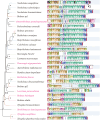Comparative and phylogenetic analyses using mitogenomes revealed gene re-arrangement of Boletaceae (Boletales)
- PMID: 40860166
- PMCID: PMC12374169
- DOI: 10.3897/imafungus.16.154192
Comparative and phylogenetic analyses using mitogenomes revealed gene re-arrangement of Boletaceae (Boletales)
Abstract
Boletaceae, the largest family in the Boletales order, is an ecologically and economically important group and the phylogenetic studies of this group need to be further developed. The mitogenome is an effective molecular marker for analysing phylogenetic relationships; however, Boletaceae mitochondrial genome (mitogenome) has been studied to a lesser extent. Thus, a comparative analysis of the mitogenomic features of seven Boletaceae species, representing seven distinct genera, was conducted. Phylogenetic relationships amongst these species within Boletales were reconstructed, based on the mitogenomic data. Highly consistent phylogenetic results within 34 Boletales species and two outgroups from Polyporales, based on mitogenomic datasets, were obtained using Maximum Likelihood and Bayesian Inference methods. Results of phylogenetic analyses revealed that Boletus, Retiboletus and Neoboletus were polyphyletic. Interestingly, species of Neoboletus with different bruising discolouration patterns were found in separate clades, suggesting this trait may reflect underlying genetic divergence. Furthermore, comparative and phylogenetic analyses revealed gene re-arrangements in mitogenomes of Boletaceae. This study is the first to report on complete mitogenomes of four genera (Amoenoboletus, Hourangia, Leccinum and Strobilomyces) and will help better understand the phylogenetic relationships of Boletales. Furthermore, addition of more new taxa is necessary to reconstruct a high-resolution tree.
Keywords: Boletaceae; conserved gene clusters; evolutionary rates; injury discolouration.
Xianyi Wang, Jiawei Tao, Zhongyao Guo, Guoyu Wang, Guangyin Xu, Yaping Wang, Yaohang Long, Hongmei Liu.
Conflict of interest statement
The authors have declared that no competing interests exist.
Figures







Similar articles
-
Prescription of Controlled Substances: Benefits and Risks.2025 Jul 6. In: StatPearls [Internet]. Treasure Island (FL): StatPearls Publishing; 2025 Jan–. 2025 Jul 6. In: StatPearls [Internet]. Treasure Island (FL): StatPearls Publishing; 2025 Jan–. PMID: 30726003 Free Books & Documents.
-
Phylogenetic taxonomy of the Zambian Anopheles coustani group using a mitogenomics approach.Malar J. 2025 Jul 1;24(1):203. doi: 10.1186/s12936-025-05461-z. Malar J. 2025. PMID: 40597261 Free PMC article.
-
The first mitogenome of Petrovinema skrjabini from Equus ferus przewalskii: a phylogenetic analysis within the Strongylidae family.Parasit Vectors. 2025 Jul 11;18(1):278. doi: 10.1186/s13071-025-06851-7. Parasit Vectors. 2025. PMID: 40646541 Free PMC article.
-
Systemic pharmacological treatments for chronic plaque psoriasis: a network meta-analysis.Cochrane Database Syst Rev. 2021 Apr 19;4(4):CD011535. doi: 10.1002/14651858.CD011535.pub4. Cochrane Database Syst Rev. 2021. Update in: Cochrane Database Syst Rev. 2022 May 23;5:CD011535. doi: 10.1002/14651858.CD011535.pub5. PMID: 33871055 Free PMC article. Updated.
-
[Volume and health outcomes: evidence from systematic reviews and from evaluation of Italian hospital data].Epidemiol Prev. 2013 Mar-Jun;37(2-3 Suppl 2):1-100. Epidemiol Prev. 2013. PMID: 23851286 Italian.
References
LinkOut - more resources
Full Text Sources
